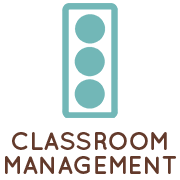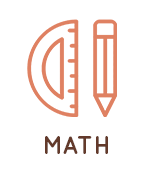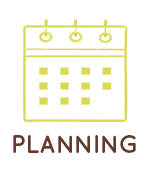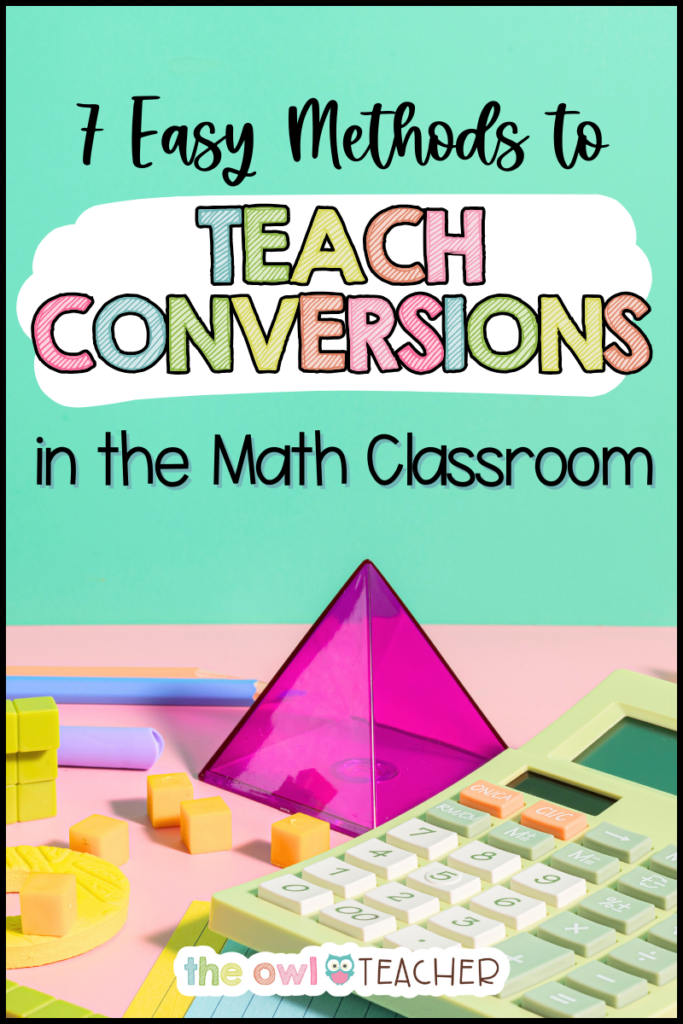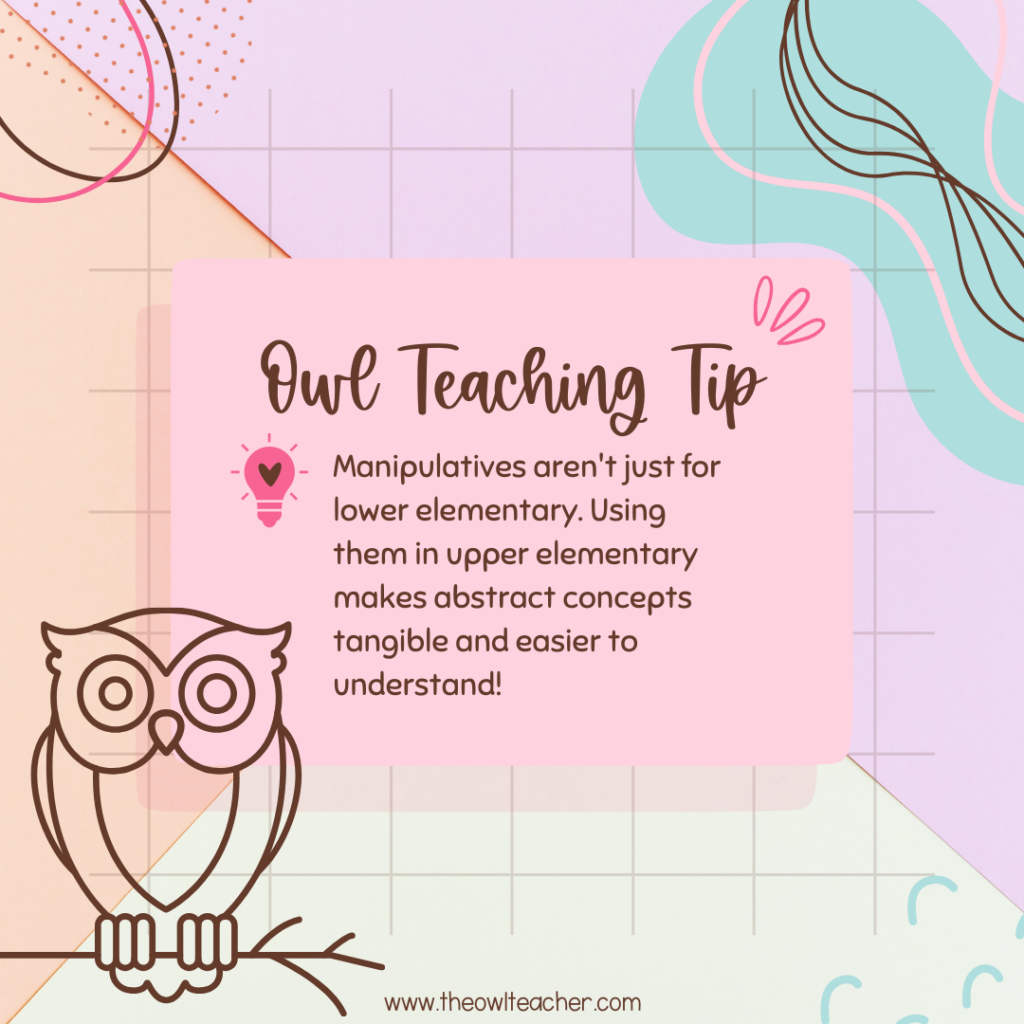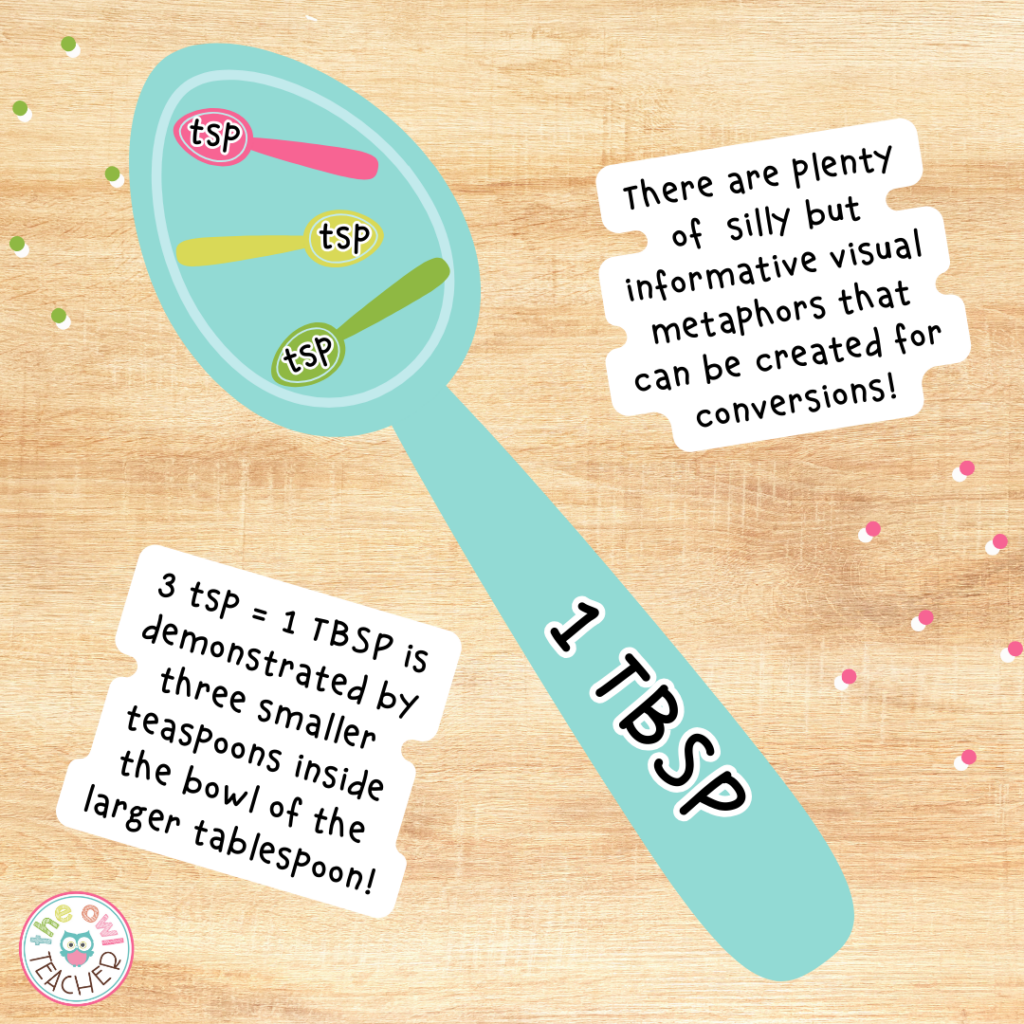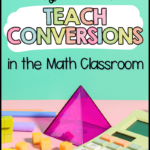
We’re already almost halfway through March. You know what that means… Testing season is coming up.
Oh, and Spring Break, also, I guess, if that’s something you’re looking forward to. 😉
While every season of testing is unique from year to year, there are plenty of reliable subjects that are always covered regardless of the manner in which the questions are posed, such as types of energy or decimals, to name a couple. There are a plethora of posts scattered across my blog on nearly every testing subject under the sun, include testing itself… Except for conversion in mathematics! Gasp!
Naturally, I’m here to remedy that situation. I’m sure you already know all about why it’s so vital to thoroughly cover conversion in your upper elementary classroom, too; after all, conversion skills are crucial for understanding and navigating the real world. Kiddos will encounter various units of measurement throughout their daily lives, such as length, weight, volume, and time. Teaching conversion equips them with the ability to make sense of and work with these different units, fostering practical everyday math skills!
Besides that, making the proper conversions involves critical thinking and problem-solving. Even in their science lessons, students will need to use math concepts to convert from one unit to another, requiring them to analyze the relationships between different units. Besides, who doesn’t love creating an integrated curriculum?
Like I said, though, I’m sure you know all about conversions and their importance in your upper elementary math classroom, so without further ado, let’s dive into seven methods to teach conversions!
Teaching Conversions in the Mathematics Classroom
1. Use Side-by-Side Comparisons
If I’ve said it once, I’ve said it a thousand times: manipulatives aren’t just for lower elementary! Abstract concepts are HARD to understand for any student, young or old, so it’s always a win when we can make those ideas concrete.
By incorporating manipulatives into your conversions unit, you can demonstrate side-by-side comparisons with a tangible and interactive learning experience. In addition, using those manipulatives makes conversions more accessible and memorable for your kiddos!
To start, you can create strips of paper to help students visualize those side-by-side comparisons. Label the strips as below:
| 12 in / 1 foot | 12 in / 1 foot | 12 in / 1 foot |
| 1 yard | ||
Of course, you should model these conversions with the real yardsticks and rulers so your students can be certain that you’re being honest… I mean, I know you are, but they may have their doubts! 😉
These comparisons don’t end there, either—another way to help your students see those side-by-side conversions is by bring in a bit of engineering! Thanks to the University of Colorado’s engineering school, your students can practice their STEM skills with this On-Track Unit Conversion activity that’s sure to give them enough visuals to last the whole lesson.
By using manipulatives, you offer your students a hands-on approach that helps solidify their understanding of conversion as well as fostering a positive and engaging math learning environment. From all sides, it’s a win!
2. Invent Creative Memorization Methods
When students are allowed to exercise their creativity, you’ll be surprised by how much easier it is for them to remember their lessons! One of my favorite ways to allow creativity when it comes to memorizing conversion rules is by creating mnemonic devices.
It can feel overwhelming to be tasked with creating a mnemonic for a rule, especially for students who aren’t quite the strongest with vocabulary. Thankfully, that’s where NASA comes in!
… Wait, NASA? Well, yes! For some reason or other, NASA hosts a “Mnemonicizer,” the self-proclaimed “mnemonic device device.” Regardless, it’s an amazing tool that helps kiddos create mnemonics with remarkable ease while allowing ample room for creativity.
To get started, give students the conversion rules:
- Large to small = multiply
- Small to large = divide
Then let them loose with the Mnemonicizer! Using the first letter of each word in the rules above, here are the mnemonic devices that I came up with:
- Labs Teach Simpler Mutts
- Snakes Through Lawns Dig
My mnemonic devices may not reach the level of fame as PEMDAS, but that’s okay. They’re silly enough for me to remember them, and that’s the important part!
3. Go Grocery Shopping
This is a fun one, and it’s a great way to make use of any old newspapers or magazines you have laying around. For this real-world activity, we’re going to let students go “shopping” for their conversions!
Begin by giving students grocery ads (or, if you don’t have any spare adverts, send them to a grocery website, like Meijer!) or something similar. Explain to your kiddos that they must determine which units of measurement can be used for certain items. For example, they may decide whether to use grams, kilograms, liters, milliliters, etc., depending on the kinds of the products in the ads.
For an added level of challenge, some items’ units may be hidden or not explicitly stated in the ads. Alternatively, you could assign specific units to different items to engage those problem-solving and critical thinking skills!
Then, students are given a set of items they must “buy” from the grocery ads. Each item comes with its own price per specific unit. For instance, the price of one item might be given in grams, while another might be in liters or pieces. Essentially, the key part of this conversions activity is having kiddos change all the prices over to a common unit of measurement in order to find the total cost.
Once students have converted all the prices over to their common unit, they can calculate the total cost of their groceries by adding up the converted prices for each item. It’s just like grocery shopping in the real world! … Kinda. 🙂
4. Use Input-Output Tables
Graphs and tables can be intimidating at first glance, but in reality, they exist to streamline information and organize it in a simple, easy-to-read manner. Graphs are an integral part of any measurements unit, and they’re just as important when it comes to teaching conversions. That’s where input-output tables come in!
Get started with your kiddos by introducing the concept of input-output tables. These tables show the relationship between input values and their corresponding output values, usually with a kind of “system” or “formula” relating them. When it comes to conversions specifically, the input values will represent quantities of one unit, such as meters in the table below, and the output values will be the equivalent quantities in another unit, shown as centimeters here:
| Meters | Centimeters |
| 1 | 100 |
| 2 | 200 |
| 3 | 300 |
| 5 | ? |
Demonstrate these conversions on the table to your students altogether, then allow them time to make their own input-output tables. Make sure to emphasize the importance of finding the patterns in the conversions and experiment with all sorts of different units!
Beyond conversions, input-output tables are a great way to tie into other mathematical concepts, too: they also help students make connections to multiplication, division, and proportional reasoning. There are patterns everywhere in math, especially with conversions. Using these tables provides kiddos with a structured and visual approach to these conversions, which promotes critical thinking and pattern recognition. Hooray for input-output tables!
5. Practice Early and Often
Well, duh, Tammy, you’re saying. Of course we’ll practice a new concept! And that’s valid! I know you will. You’re a great teacher, after all!
However, I want to be a bit more specific. When it comes to conversions, it’s a MUST to regularly practice and review equivalent measurements. Conversions are an integral skill that will be used throughout students’ entire lives and needs to be as easy as quick mental math. When you’re trying to scout a good deal at a grocery store, you don’t want to get stuck trying to recall how many grams are in a kilogram.
Conversions review can be done in a number of ways, from concentration/memory games to “Find the Error” activities, revising recipes, or even using sentence frames. Sentence frames especially are a great way to quickly check for understanding, and they make for an excellent ticket-out-the-door or other informal assessment.
Hey, Tammy, that’s a great idea! In fact, I love the concept of using sentence frames for conversions so much that I’ll even give you an easy example to copy over on your whiteboard:
- There are ____ mg in 1 g
- There are ____ cg in 1 g
- There are ____ g in 1 kg
Wow. Beautiful, right? I know. I’m just so clever! Regardless, sentence frames really are a great way to practice, practice, practice those conversions until they become as fluent as multiplication facts! Your kiddos are fluent in multiplication facts, right? 😉
6. Create a Measurement Art Collage
In case you couldn’t tell, I’m a firm believer in implementing creativity into lessons, especially when it comes to stereotypically “boring” subjects such as math. That’s why your kiddos will be treated to a measurement art collage to break up that math monotony!
To participate, have students create a kind of visual that readily displays a set of conversions and units. For example, they can create a visual metaphor for how many teaspoons are in a tablespoon by drawing a larger spoon (the tablespoon) with three smaller spoons (the teaspoons) inside the bowl of the large spoon. And, in case you’re wondering, I DID have to ask Alexa how many teaspoons are in a tablespoon… I don’t bake much.
There are lots of other visuals out there, too, when it comes to conversions. If you want to show your kiddos a few examples, check out the Gallon Man or the “Large G” image, both of which are featured in this blog post!
Whether you assign a set of units to individual students or simply keep track of everyone’s choices, try to make sure that you’re entertaining a wide variety of conversions so that your classroom’s art collage isn’t stale and repetitive. Once every student has created their visual metaphors, display them up on a bulletin board or in the hallway!
7. Combine Conversions with Science
Guess what? Tammy’s back with another way to integrate that curriculum, this time with more science! Combine conversions with environmental science with the help of PBS and their “Unit Conversion: Water Use” activity. Not only is this activity perfect for the springtime, it also aligns with CCSS related to measurement and conversions in upper elementary.
Oh, and in the spirit of Earth Day, students also get to learn a few tips and tricks for conserving water! There are even a few fractions tossed in, too, which is always a bonus. A bonus for you, I mean—your kiddos might not like the fraction part too much, but that’s okay. 🙂
Ultimately, conversion skills are CRUCIAL for understanding and navigating the real world. Students will regularly encounter a vast array of units of measurement in daily life, such as length, weight, volume, time, and so on. By allowing kiddos to thoroughly explore conversions, you’re effectively equipping them with the ability to make sense of and work with these different units, fostering practical, everyday math skills that will last a lifetime.
And that’s not even to mention the global perspective! America is somewhat infamous for its imperial system of measurement despite the fact that the majority of other countries as well as scientists use the metric system. In an increasingly interconnected world, understanding and converting between these different units of measurement is all too necessary!
For now, however, it’s time to convert this paragraph into a farewell for now. Before you go, make sure to sign up for my email list so you never miss another lovely post like this one, and share with a teaching pal so they can do the same. You’re the best!


